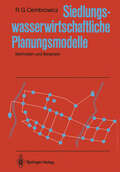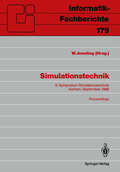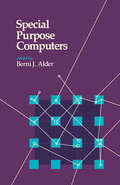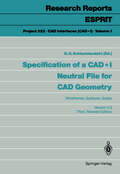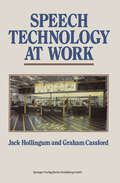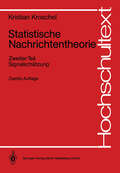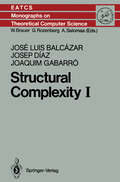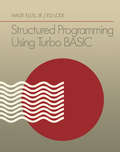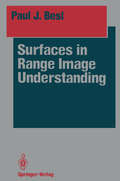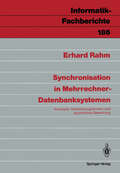- Table View
- List View
Servicing Personal Computers
by Michael TooleyServicing Personal Computers, Second Edition focuses on the techniques and processes involved in the repair of personal computers. The book first discusses microcomputer systems. Microprocessors, Z80 support devices, random access memory, parallel input and output, and memory mapped input and output are then explained. The text looks at test equipment, printers and monitors, and tapes and disk drives. The publication also discusses fault diagnosis and considers initial check procedures, testing the CPU board, and miscellaneous faults. The book then underscores the servicing of IBM PC and compatibles. The 8086 and 8088 microprocessors, 8086 registers, 80286 microprocessor, support devices, and useful memory locations are described. The text also presents commonly used symbols, TTL families and device numbering, common TTL pin-outs, RAM data, and equivalent logic functions. The selection is a vital source of information for those interested in personal computer repair.
Signal Processing and Pattern Recognition in Nondestructive Evaluation of Materials (NATO ASI Subseries F: #44)
by C. H. ChenThe NATO Advanced Research Workshop on Signal Processing and Pattern Recognition in Nondestructive Evaluation (NOE) of Materials was held August 19-22, 1987 at the Manoir St-Castin, Lac Beauport, Quebec, Canada. Modern signal processing, pattern recognition and artificial intelligence have been playing an increasingly important role in improving nondestructive evaluation and testing techniques. The cross fertilization of the two major areas can lead to major advances in NOE as well as presenting a new research area in signal processing. With this in mind, the Workshop provided a good review of progress and comparison of potential techniques, as well as constructive discussions and suggestions for effective use of modern signal processing to improve flaw detection, classification and prediction, as well as material characterization. This Proceedings volume includes most presentations given at the Workshop. This publication, like the meeting itself, is unique in the sense that it provides extensive interactions among the interrelated areas of NOE. The book starts with research advances on inverse problems and then covers different aspects of digital waveform processing in NOE and eddy current signal analysis. These are followed by four papers of pattern recognition and AI in NOE, and five papers of image processing and reconstruction in NOE. The last two papers deal with parameter estimation problems. Though the list of papers is not extensive, as the field of NOE signal processing is very new, the book has an excellent collection of both tutorial and research papers in this exciting new field.
Simulated Annealing for VLSI Design (The Springer International Series in Engineering and Computer Science #42)
by D.F. Wong H.W. Leong H.W. LiuThis monograph represents a summary of our work in the last two years in applying the method of simulated annealing to the solution of problems that arise in the physical design of VLSI circuits. Our study is experimental in nature, in that we are con cerned with issues such as solution representations, neighborhood structures, cost functions, approximation schemes, and so on, in order to obtain good design results in a reasonable amount of com putation time. We hope that our experiences with the techniques we employed, some of which indeed bear certain similarities for different problems, could be useful as hints and guides for other researchers in applying the method to the solution of other prob lems. Work reported in this monograph was partially supported by the National Science Foundation under grant MIP 87-03273, by the Semiconductor Research Corporation under contract 87-DP- 109, by a grant from the General Electric Company, and by a grant from the Sandia Laboratories.
Simulation und moderne Programmiersprachen: Modula-2, C, Ada (Fachberichte Simulation #8)
by Bernd Page Rolf Bölckow Andreas Heymann Ralf Kadler Hansjörg LiebertSimulationstechnik: 5. Symposium Simulationstechnik Aachen, 28.–30. September 1988 Proceedings (Informatik-Fachberichte #179)
by Walter AmelingDer Band enthält die Beiträge zum 5. Symposium Simulationstechnik, das im September 1988 an der RWTH Aachen stattfand. Die Vorträge reflektieren den State-of-the-Art der Simulationstechnik in allen Anwendungsbereichen. Das Ziel dieser von ASIM veranstalteten Reihe von Symposien ist es, den Austausch von Ideen und Erfahrungen von Fachleuten und Interessenten zu fördern, die auf dem Gebiet der Modellbildung und Simulation in Theorie und Praxis tätig sind. Dieses Tagungsziel wird vor dem Hintergrund der zunehmend breiten Bedeutung, die der Simulation als modernem Entwicklungs- und Analysehilfsmittel zukommt, immer wichtiger. Neue Hard- und Softwarekonzepte ermöglichen die Entwicklung hochkomplexer Systeme. Das vielfältige Zusammenwirken der Systemkomponenten zu untersuchen und zu bewerten, ist ohne den Einsatz leistungsfähiger Simulationswerkzeuge undenkbar. Dies erfordert konsequenterweise auch Weiterentwicklungen auf dem Gebiet der Simulationstechnik und der ihr jeweils zugrunde liegenden Methodik. Der Erfahrungsaustausch im Rahmen einer solchen Tagung bietet allen Teilnehmern in gleicher Weise Vorteile: Einerseits erlangen Praktiker frühzeitig Kenntnis von neuen Konzepten und Werkzeugen, und andererseits können Theoretiker frühzeitig die vielfältigen in der Praxis auftretenden Probleme bei der Entwicklung neuer Methoden bewerten und berücksichtigen. Der Band ist thematisch gegliedert in die drei Teile Modellbildung und Simulationstechnik, Simulationswerkzeuge sowie Anwendungen.
Social Science Research on CAD/CAM: Results of a First European Workshop
by Michael Rader Bernd Wingert Ulrich RiehmComputer Aided Design (CAD) and Computer Aided Manufacture (CAM) are but two of the more recent examples of computer applications in domains previously dominated by human labour. The use of computers in such areas has increasingly attracted social science research. There are several reasons one could suggest for this, not least of them being the simple fact that public money is being provided for such research. Of course, some of the interest may be due to the wish to prove that technology is being used to inhuman ends, but undoubtedly there is also some degree of fascination involved. Can you really do all the things with computers that people claim you can? There is certainly satisfaction to be had from smugly pointing out its shortcomings, but many of the few sociologists in our own organisation are also among the most avid users of modern technology. Needless to say, they also belong to the most critical users of the technology! A new strain of motivation for social science research which appears to be gaining significance, is the desire to "re-direct" technology, or at least - and probably more realistically - to playa part in shaping future technology . The entire range of motives may be recognised in the collection of papers contained in this volume.
Software Diversity in Computerized Control Systems (Dependable Computing and Fault-Tolerant Systems #2)
by Udo VogesSoftware Diversity is one of the fault-tolerance means to achieve dependable systems. In this volume, some experimental systems as well as real-life applications of software diversity are presented. The history, the current state-of-the-art and future perspectives are given. Although this technique is used quite successfully in industrial applications, further research is necessary to solve some open questions. We hope to report on new results and applications in another volume of this series within some years. Acknowledgements The idea of the workshop was put forward by the chairpersons of IFIP WG lOA, J. -c. Laprie, J. F. Meyer and Y. Tohma, in January 1986, and the edi tor of this volume was asked to organize the workshop. This volume was edited with the assistance of the editors of the series, A. AviZienis, H. Kopetz and J. -C. Laprie, who also had the function of reviewers. Karlsruhe, October 1987 U. Voges, Editor Table of Contents . . . . . . . . . . . . . . . . . . . . . . . . . . . . . . . 1 1. Introduction U. Voges 2. Railway Applications . . . . . . . . . . . . . . . . . . . . . . . . . . . . . . . . 7 ERICSSON Safety System for Railway Control . . . . . . . . . . . . . . . . . . 11 G. Hagelin 3. Nuclear Applications . . . . . . . . . . . . . . . . . . . . . . 23 Use of Diversity in Experimental Reactor Safety Systems . 29 U. Voges The PODS Diversity Experiment . 51 P. G. Bishop 4. Flight Applications . . . . . . . . . . . . . . . . . . . . . . . . . 85 AIRBUS and ATR System Architecture and Specification. . 95 P. Traverse 5. University Research . . . . . . . . . . . . . . . . . . . 105 Tolerating Software Design Faults in a Command and Control System . . . . . . . . . . . . . . . . . . . . . . 109 T. Anderson, P. A. Barrett, D. N. Halliwell, M. R. Moulding DEDIX 87 - A Supervisory System for Design Diversity Experiments at UCLA . . . . . . . . . . . . . . . . . .
Software Engineering in C (Springer Books on Professional Computing)
by Peter A. Darnell Philip E. MargolisThe author starts with the premise that C is an excellent language for software engineering projects. The book con- centrates on programming style,particularly readability, maintainability, and portability. Documents the proposed ANSI Standard, which is expected to be ratified in 1987. This book is designed as a text for both beginner and inter- mediate-level programmers.
Software for Computer Control 1986: Selected Papers from the Fourth IFAC/IFIP Symposium, Graz, Austria, 20-23 May 1986 (IFAC Symposia Series)
by D. Florian V. HaaseThis volume studies the advances of software for computers, their development, applications and management. Topics covered include software project management, real time languages and their uses, and computer aided design techniques. The book also discusses how far artificial intelligence is integrated with business and industry to give a complete overview of the role of computer systems today.
Solitons: Introduction and Applications (Springer Series in Nonlinear Dynamics)
by Muthusamy LakshmananA good deal of the material presented in this book has been prepared by top experts in the field lecturing in January 1987 at the Winter School on Solitons in Tiruchirapalli,India. The lectures begin at an elementary level but go on to include even the most recent developments in the field. The book makes a handy introduction to the various facets of the soliton concept, and will be useful both to newcomers to the field and to researchers who are interested in developments in new branches of physics and mathematics.
Solvable Models in Quantum Mechanics (Theoretical and Mathematical Physics)
by Sergio Albeverio Friedrich Gesztesy Raphael Hoegh-Krohn Helge HoldenNext to the harmonic oscillator and the Coulomb potential the class of two-body models with point interactions is the only one where complete solutions are available. All mathematical and physical quantities can be calculated explicitly which makes this field of research important also for more complicated and realistic models in quantum mechanics. The detailed results allow their implementation in numerical codes to analyse properties of alloys, impurities, crystals and other features in solid state quantum physics. This monograph presents in a systematic way the mathematical approach and unifies results obtained in recent years. The student with a sound background in mathematics will get a deeper understanding of Schrödinger Operators and will see many examples which may eventually be used with profit in courses on quantum mechanics and solid state physics. The book has textbook potential in mathematical physics and is suitable for additional reading in various fields of theoretical quantum physics.
Special Purpose Computers
by Berni J. AlderSpecial Purpose Computers describes special-purpose computers and compares them to general-purpose computers in terms of speed and cost. Examples of computers that were designed for the efficient solution of long established algorithms are given, including Navier-Stokes hydrodynamic solvers, classical molecular dynamic machines, and Ising model computers.Comprised of seven chapters, this volume begins by documenting the progress of the CalTech Concurrent Computation Program and its evolution from computational high-energy physics to a supercomputer initiative, with emphasis on the lessons learned including computer architecture issues and the trade-offs between in-house and commercial development. The reader is then introduced to the QCD Machine, a special-purpose parallel supercomputer that was designed and built to solve the lattice quantum chromodynamics problem. Subsequent chapters focus on the Geometry-Defining Processors and their application to the solution of partial differential equations; the Navier-Stokes computer; parallel processing using the Loosely Coupled Array of Processors (LCAP) system; and the Delft Ising system processor. The design and implementation of the Delft molecular-dynamics processor are also described.This book will be of interest to computer engineers and designers.
Specification of a CAD * I Neutral File for CAD Geometry: Wireframes, Surfaces, Solids Version 3.3 (Research Reports Esprit #1)
by E. G. SchlechtendahlESPRIT Project 322, "CAD Interfaces", has been established to define the most important interfaces in CAD/CAM systems for data exchange, data base, finite element analysis, experimental analysis, and advanced modeling. The definitions of these interfaces are being elaborated in harmony with international standardization efforts in this field. One principal goal of the project is to develop techniques for the exchange of CAD information between CAD systems, and from the CAD domain to CAA (Computer Aided Analysis) and CAM (Computer Aided Manufacturing). This volume presents a proposal for a neutral file format for CAD data: curves, surfaces, and solids. The specification is based on a reference schema for CAD data bases and is defined informally with respect to its semantics and formally with respect to its syntax. This volume is a revised edition of "Specification of a CAD*I Neutral File for Solids" Version 3.2. The revision reflects the enhancements which result from the implementation of communication processors in eight different CAD systems and from the practical exchange of solid models between these systems. Due to the close interaction between the CAD*I project and the coming-up international standard STEP this specification also serves as an introduction to the geometry model that will be included in the future international standard.
Speech Technology at Work
by Jack Hollingum Graham CassfordSpeech technology - the use of speech as a means of sending information to, and receiving information from computer systems has been in use as a research tool for many years. Only recently has it begun to move out of the laboratory and into commercially worthwhile applications, first with compressed and synthesised spoken messages, then with computer recognition of spoken messages, and today with diverse applications involving both recognition and reproduction of human speech. We have written this book because we believe the technology has now advanced to the point where many more applications of voice recognition and response are both feasible and economically attractive. Computers that can understand everyday speech are still a distant prospect, but provided the limitations of present day equipment are clearly understood there is much that can be achieved with it. Our aim is to show, in non-technical language, what is now possible with the help of speech technology. The text includes many examples of current applications in industry, commerce and other fields, and we have selected five current industrial applications combining speech recognition and response for more detailed attention. Industrial cases have been chosen both because we see industry as an important growth area for speech applications in the next few years, and because it presents some of the greatest difficulties in speech recognition - if you can make it work in industry, then you can make it work almost anywhere.
The Spinorial Chessboard (Trieste Notes in Physics)
by Paolo Budinich Andrzej TrautmanSpinor theory is an important tool in mathematical physics in particular in the context of conformal field theory and string theory. These lecture notes present a new way to introduce spinors by exploiting their intimate relationship to Clifford algebras. The presentation is detailed and mathematically rigorous. Not only students but also researchers will welcome this book for the clarity of its style and for the straightforward way it applies mathematical concepts to physical theory.
Standard Relational and Network Database Languages
by E.J. Yannakoudakis C.P. ChengFor any type of software to become standard, whether a third genera tion language or an integrated project support environment (IPSE), it must undergo a series of modifications and updates which are a direct result of theoretical and empirical knowledge gained in the process. The database approach to the design of general purpose infonn ation systems has undergone a series of revisions during the last twenty years which have established it as a winner in many different spheres of infonnation processing, including expert systems and real time control. It is now widely recognised by academics and practitioners alike, that the use of a database management system (DBMS) as the under lying software tool for the development of infonnation/knowledge based systems can lead to environments which are: (a) flexible, (b) efficient, (c) user-friendly, (d) free from duplication, and (e) fully controllable. The concept of a DBMS is now mature and has produced the software necessary to design the actual database holding the data. The database languages proposed recently by the International Organisa tion for Standardisation (ISO) are thorough enough for the design of the necessary software compilers (i.e programs which translate the high level commands into machine language for fast execution by the computer hardware). The ISO languages adopt two basic models of data and therefore two different sets of commands: (a) the relational, implemented via the relational database language (RDL), and (b) the network, imple mented via the network database language (NDL).
Stochastic Mechanics and Stochastic Processes: Proceedings of a Conference held in Swansea, UK, August 4-8, 1986 (Lecture Notes in Mathematics #1325)
by Aubrey Truman Ian M. DaviesThe main theme of the meeting was to illustrate the use of stochastic processes in the study of topological problems in quantum physics and statistical mechanics. Much discussion of current problems was generated and there was a considerable amount of interaction between mathematicians and physicists. The papers presented in the proceedings are essentially of a research nature but some (Lewis, Hudson) are introductions or surveys.
Structural Complexity I (Monographs in Theoretical Computer Science. An EATCS Series #11)
by Jose L. Balcazar Josep Diaz Joaquim GabarroSince the achievement of a fonnal definition of the concept of "algorithm", the Mathematical Theory of Computation has developed into a broad and rich discipline. The notion of "complexity of an algorithm" yields an important area of research, known as Complexity Theory, that can be approached from several points of view. Some of these are briefly discussed in the Introduction and, in particular, our view of the "Structural" approach is outlined there. We feel the subject is mature enough to permit collecting and interrelating many of the results in book fonn. Let us point out that a substantial part of the knowledge in Structural Complexity Theory can be found only in specialized journals, symposia proceedings, and monographs like doctoral dissertations or similar texts, mostly unpublished. We believe that a task to be done soon is a systematization of the interconnections between all the research lines; this is a serious and long task. We hope that the two volumes of this book can serve as a starting point for this systematization process.
Structured Programming Using Turbo BASIC
by Wade Ellis Ed LodiStructured Programming Using Turbo BASIC explains programming methods using this language through mathematical or business examples and problems. The book approaches problem-solving using a top-down, structured programming method. This method consists of 1) breaking a problem into smaller, more manageable tasks, and 2) using the action block, the decision block, and the loop block—the three fundamental programming structures—to perform each task. The text describes the Turbo Basic environment on an IBM PC or compatible, the fundamental programming structures and concepts, the two data structures (arrays, files), graphics creation, as well as computer simulations. The book explains in detail variables, screen formatting, the decision block, the loop block, functions. The text also discusses parameter lists, and libraries The student learns to use the OPEN statement to associate a buffer with a file, or the CLOSE statement to end the file/buffer. The text explains the use of the Turbo BASIC random generator that produces unique sequences of random numbers. The book can be used in introductory lecture courses in business, computer science, or mathematics. It can be beneficial for students in an open-entry/open-exit computer laboratory courses or for self-study.
Surfaces in Range Image Understanding (Springer Series in Perception Engineering)
by Paul J. BeslMachine perception requires the digitization of physically-sensed signals. During the last ten years, digital range images have become available from a variety of sensors. This book is devoted to the problem of range image understanding with computers. Its aims are to develop a theoretical framework, devise appropriate algorithms, and demonstrate a software implementation of those algorithms that will confirm the usefulness of surfaces in range image understanding. It will be of interest to the researcher studying the theoretical concepts of image understanding, as well as the engineer who wants to implement these concepts in practical applications.
Synchronisation in Mehrrechner-Datenbanksystemen: Konzepte, Realisierungsformen und quantitative Bewertung (Informatik-Fachberichte #186)
by Erhard RahmSyntactic and Structural Pattern Recognition (NATO ASI Subseries F: #45)
by Gabriel Ferrate Theo Pavlidis Alberto Sanfeliu Horst BunkeThirty years ago pattern recognition was dominated by the learning machine concept: that one could automate the process of going from the raw data to a classifier. The derivation of numerical features from the input image was not considered an important step. One could present all possible features to a program which in turn could find which ones would be useful for pattern recognition. In spite of significant improvements in statistical inference techniques, progress was slow. It became clear that feature derivation was a very complex process that could not be automated and that features could be symbolic as well as numerical. Furthennore the spatial relationship amongst features might be important. It appeared that pattern recognition might resemble language analysis since features could play the role of symbols strung together to form a word. This led. to the genesis of syntactic pattern recognition, pioneered in the middle and late 1960's by Russel Kirsch, Robert Ledley, Nararimhan, and Allan Shaw. However the thorough investigation of the area was left to King-Sun Fu and his students who, until his untimely death, produced most of the significant papers in this area. One of these papers (syntactic recognition of fingerprints) received the distinction of being selected as the best paper published that year in the IEEE Transaction on Computers. Therefore syntactic pattern recognition has a long history of active research and has been used in industrial applications.

